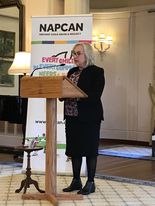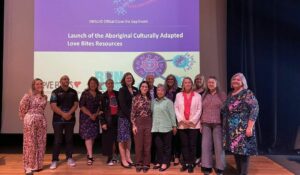NAPCAN thanks the National Children’s Commissioner, Anne Hollonds, for her insightful keynote address at the official launch of National Child Protection Week, Government House, Canberra, 5 September 2022.
The media release relating to the address can be found on the Commissioner’s website, and coverage of the story can be found on SBS.
Notes from her speech are included below:
Every child, in every community, needs a fair go. Shining a light on supporting children to grow up safe and supported
His Excellency General the Honourable David Hurley AC DSC, Governor-General of Australia, and Her Excellency Mrs Linda Hurley
Thank you for launching National Child Protection Week 2022 and for hosting us today.
I would like to acknowledge the traditional owners of this land, the Ngunnawal people, and pay my respect to their elders, past, present and emerging, and to all Aboriginal and Torres Strait Islander people joining us today.
Thank you to the NAPCAN for inviting me to speak today.
National Child Protection Week is an important time to focus our attention on the rights and wellbeing of Australia’s children and their families and communities.
The theme for Child Protection Week invites us to reflect on the fact that ‘Every child, in every community, needs a fair go.’
The theme also reminds us that sadly we are still a long way from achieving this goal.
I will argue that in Australia the wellbeing of children is not a national priority.
That today children are at risk of harm because the basic systems that are meant to provide support, continue to fail them.
And that because of these systemic failures, we as a country are currently unable to ‘give every child …. a fair go’.
A key human rights challenge affecting children in Australia is the fragmentation and failure of our basic systems that are meant to support children and their families, especially those living with poverty and disadvantage.
Urgent cross-portfolio reform is needed across health, education, and social services including housing and income security, to ensure that these basic systems are fit-for-purpose, and can help families to keep their children safe and well.
We know that:
In Australia you are more likely to live in poverty if you are a child: 1 in 6 children lives in poverty.
Child poverty is well known to be a risk factor connected to many life-long harms. This is being addressed elsewhere in the world, such as all the European Union nations that have made a shared commitment to combat child poverty and exclusion through their Child Guarantee National Action Plans.
At the Jobs & Skills Summit held last week, it was noted that ‘the learning gap between students from disadvantaged and advantaged backgrounds more than doubles between Year 3 and Year 9’.
According to the OECD, 20% of Australian 15-year-olds lack sufficient literacy skills to participate effectively in everyday activities that require reading and writing.
Suicide has, for many years, been the leading cause of death for children and young people aged 5-17, with First Nations children disproportionately affected.
And Australia ranks a low 32nd out of 38 OECD countries on child wellbeing.
Unlike many other developed countries, we have no national roadmap to improve child health, learning and wellbeing.
What we do have is a chronic crisis in our child protection and youth justice systems.
We don’t often focus on the children in youth detention centres in Child Protection Week, but it’s important to remember that most of these children have come via the child protection system, and that they are in need of care and protection.
20 suicide attempts and 285 occasions of self-harm in the first six months of this year at Banksia Hill Youth Detention Centre in WA. These children have been frequently locked down in isolation in their cells for more than 22 hours per day, deprived of education, recreation, or rehabilitation, in a system that has failed.
While Banksia Hill requires urgent intervention, it’s sadly not isolated.
Five years on from the NT Royal Commission, the serious problems in youth justice systems continue, right across Australia.
Official reports have repeatedly described the treatment of children in some youth detention centres as inhumane and degrading.
Recently we heard horrifying accounts of child sexual abuse and what can only be described as ‘torture of children’, at Tasmania’s Ashley Youth Detention Centre.
I will quote the Counsel Assisting the Tasmanian Commission of Inquiry in her closing remarks:
‘There appears to be a lack of urgency from the government to change the situation for these children …
A failure to act now …….. will see children continue to be subjected to inhumane and degrading conditions and continue to be at risk of child sex abuse.’
Children in youth detention need care and treatment for complex neurological disabilities, trauma, and serious mental health problems.
Instead of receiving the specialist care they need, too many children are incarcerated in harmful conditions with life-long negative effects. And they’re not provided with rehabilitation and the support they need to integrate back into the community on release.
These children come from families living with poverty and disadvantage. They are disproportionately First Nations children, and some are only 10 years old.
I’ve spoken with many of these children when I visited these prisons. It was distressing and heartbreaking.
Australia is out of step internationally and the public needs to know the truth: we are wasting public money because locking up children does not reduce crime.
Other countries have implemented community-based welfare approaches, shown to reduce youth offending and to keep the community safer.
This community-based early intervention and support works better to reduce youth offending than even the best rehabilitation programs provided in prisons.
Let’s be clear: The chronic crisis in Australia’s youth justice system is an outcome of our policies and basic service systems that are failing to provide children and their families with the support they need, leading to more children coming into the child protection and into youth justice.
In our ‘Keeping Kids Safe and Well’ national consultations with children and their families for the new National Framework for Protecting Australia’s Children, I heard that basic support systems are fragmented and not fit for purpose.
We need to redesign our basic services by listening to what children and their families say will help them.
Children say they want to go to school, but they feel they don’t belong and their families don’t feel welcome.
OECD research has found that students from families with higher socio-economic status are more likely to feel a sense of belonging at school.
In Australia, this gap has grown wider, and we know that disengagement from education is a key risk factor for serious problems like youth crime.
The question is: what are we doing to prevent the escalation of these problems?
Do we understand the urgency to act on the evidence?
And are we redesigning the way schools operate, to embrace local children and their families, especially those at risk of disengagement?
For example, integrating schools with local health and family support services in a multi-disciplinary hub. This would help to re-engage children and their families, and this wraparound support for all family members is what they have recommended.
Two years of COVID amplified the weaknesses in our critical support infrastructure.
And we now have research showing the negative outcomes on the mental health, learning and wellbeing of many children.
COVID demonstrated that policy is typically designed for the concerns of adults and that the unique needs of children are overlooked.
Children had no voice and no one representing them at the top decision-making table during the pandemic. We have no Chief Paediatrician and no Minister for Children.
The UN Convention on the Rights of the Child asks us to listen to what matters most to children and to give their views due weight.
This is how we can design better policy and support services.
Eg In our recent survey on mental health, children and young people aged 9-17 told us that the first people they turn to for help are parents and family.
So amongst other actions, we need to equip parents with a better understanding of what they can do to support the mental health of their children.
Family relationships are what matters most to children.
In fact Melbourne University researchers heard from children that it’s the quality of family relationships that defines for them what the very concept of ‘home’ means.
For children, the impacts of poverty are multidimensional and persistent.
ANU Prof Sharon Bessell interviewed children about poverty, and heard that ‘relationships are deeply affected by the pressures that poverty creates’.
Poverty matters to children in ways that we would not have understood if we didn’t ask them.
In our consultations, children expressed concern about the wellbeing of their parents who were unable to get help, and the top three barriers to child safety and wellbeing were:
- lack of affordable secure housing,
- lack of access to mental health services, and
- lack of basic needs, such as food and clothing.
So what do we need to do to keep children safe and well?
Well, I think we know what to do, the problem is we are not doing it. We have a ‘doing’ problem. It’s about accountability for action.
For a start, we should implement the evidence-informed recommendations from decades of research, enquiries and Royal Commissions, and to rise above the excuse of the Federation.
Children and their families don’t live in one policy silo. Their needs stretch across numerous government portfolios and jurisdictions.
That’s why it’s complex, but we can no longer afford to use complexity as an excuse for not acting on the evidence.
Currently, we’re spending much more money on late reactions, such as youth detention and child protection systems, instead of investing in prevention and early intervention to keep children safe and well in their communities.
Our health, education and social service systems are fragmented and not fit for purpose for children and their families living with poverty and disadvantage.
Many of these families have told me directly about their frustrations at being unable to access support for their basic needs.
A country that values children would be trying hard to address child poverty, and shift investment upstream and earlier, to redesign the basic systems of support so that kids don’t fall in the gaps.
Australia has no national plan for child wellbeing and no Minister for Children.
Nor do we have cross-portfolio leadership, like a taskforce to address the system failures which are barriers to child safety and wellbeing.
Australia cannot continue to simply tinker around the edges with the symptoms.
We need a co-ordinated national approach to address the underlying causes of harms to children, and we need a much greater sense of urgency.
It’s puzzling to me that we would not recognise the benefits of doing all we can to improve the basic systems of support for children and their families.
It’s not a lack of money that is the barrier, it’s about priorities. And it’s about spending the money in smarter ways.
We need to build a roadmap for cross-portfolio systems redesign, and we need to start now.
Otherwise, we will still be having this same conversation in Child Protection Week 2032 ….. and beyond.
It’s not enough for us to care about our own children and grandchildren.
We need to care about all children and to create the conditions that keep children safe and well.
This requires each of us to step up in our own communities and to expect much more from our elected representatives in government.
I’m confident that we can make significant progress on child safety and wellbeing, but I also know that this will not be achieved without significant systems reform.
We need to make children a national priority.
We are less of a country if we don’t.




